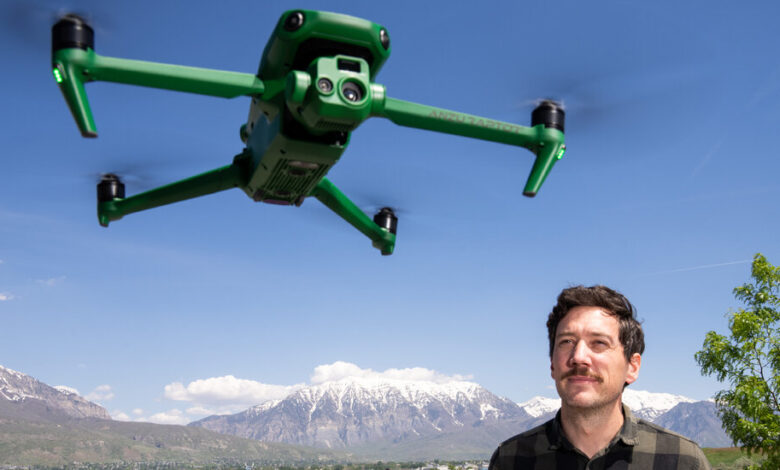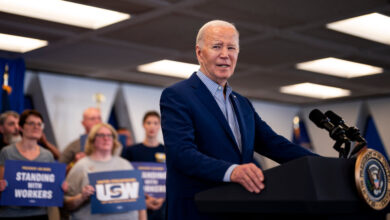Are These Drones Too Chinese to Pass U.S. Muster in an Anti-China Moment?

A one-man startup believes it has an answer to U.S. government concerns over the Chinese-made drones that dominate commercial sales in the American market.
Anzu Robotics’s chief executive and founding partners are all American, and the company’s headquarters is in Texas. The company’s drones, which are expected to be used by law enforcement agencies, utilities, architects and others, are assembled in Malaysia, and they run on servers sitting in Virginia.
There’s just one problem: Anzu has multiple close ties to China and to DJI, the Shenzhen-based firm being targeted by legislative and regulatory efforts to curb sales of Chinese drones in the United States.
Roughly half of Anzu’s parts come from China. Much of its software originated there. Anzu licensed the design for its drones from DJI, which receives a payment for every drone that Anzu orders from its manufacturer in Malaysia.
That crossover is raising questions about whether Anzu is truly independent of DJI, China’s leading drone maker, or simply a rebranded version of it.
Despite accounting for 58 percent of commercial drones sold in the United States, according to a 2022 analyst report, DJI’s business has been shadowed of late by federal and state regulations intended to guard against potential Chinese access to information gathered by drones in America.
The company now faces a major threat from a bipartisan bill in the House that would sharply curtail its future access to the U.S. communications infrastructure on which its products run.
Given its links to DJI, Anzu is in some ways a litmus test for Chinese companies facing an increasingly hostile regulatory environment in the United States.
If shifting manufacturing out of China and distributing its products through a company with an American ZIP code can help avoid being blacklisted by federal agencies or effectively outlawed by Congress, the formula Anzu has established could work not just for DJI but for other Chinese companies whose business in the United States comes under scrutiny.
If those efforts fail, it would be another setback for Chinese businesses attempting to navigate intensifying suspicion of and animosity toward China in Washington.
Randall Warnas, Anzu’s chief executive and sole employee, said in an interview that in exchange for giving Anzu a commercial license, DJI receives a cut of every dollar Anzu pays to its Malaysian manufacturer for making its drones.
Yet he acknowledged that Anzu was essentially DJI’s idea.
Early last year, he recalled, a DJI representative who said she was speaking for the company’s senior leadership approached a group of U.S. drone-industry executives with the question: “What would be the appetite to try to make it so that we could take our technology — DJI technology — and make it suitable for long-term use in the United States?”
DJI’s concept — which according to Mr. Warnas was also floated by several other DJI employees — was embraced by Anzu’s founders: himself and three partners who he said are U.S. citizens.
Their goal, he said, “was to somehow cleanse the Chinese-ness from their technology to make it so that there was still an avenue” for sales in the United States.
Mr. Warnas has been in contact with the office of Representative Elise Stefanik, the New York Republican who has spearheaded new legislation to effectively ban future operations of DJI drones in America, to discuss Anzu’s efforts and how to comply with U.S. regulations. But Ms. Stefanik was apparently unmoved by the hour-plus-long question-and-answer session that Mr. Warnas said he held with one of her staff members on Thursday.
“This desperate attempt to evade tariffs and sanctions is futile,” Ms. Stefanik said in a statement on Friday. “DJI and all of its shell companies will be held accountable.”
Regina Lin, a spokeswoman for DJI, said in a statement that her company’s licensing partnership with Anzu “was established with the goal of enhancing the accessibility of capable and cost-effective drones in the market.” She said that DJI had no other financial ties to Anzu, calling Anzu “a completely independent company.”
Some analysts said that while Anzu’s gambit may succeed in the short run, its business model could soon be threatened by the stricter guardrails Congress and regulators are considering placing around Chinese companies and their affiliates in the United States.
“It’s a Band-Aid on a bullet wound,” said Craig Singleton, China program director at the nonpartisan Foundation for Defense of Democracies.
Still, some lawyers and drone-industry veterans said they admired Anzu’s creative strategy and saw no imminent regulatory risks to its business model.
“Anzu Robotics is doing what many in our industry have been begging for,” said Chris Fink, a drone dealer in Fayetteville, Ark., who has fielded inquiries about Anzu drones from users who are leery of buying Chinese products in the current regulatory environment but can’t afford to buy drones made in America.
Anzu officially launched in April, four months after receiving equipment approvals from the Federal Communications Commission in Washington. Anzu has already received thousands of inquiries about its drones, Mr. Warnas said. He estimated that those inquiries had led to at least 400 orders, all of which were referred to third-party brokers in the United States like Mr. Fink.
The company is run out of the home office of Mr. Warnas, a longtime drone salesman who worked for DJI earlier in his career and served briefly as chief executive of Autel, another Chinese drone marker, in 2021. He resigned after just nine weeks, blaming his lack of autonomy for the short stint.
Mr. Warnas, an American citizen, lives outside Salt Lake City, Utah. But Anzu collects mail at a corporate office complex in Austin, Texas, and lists that address as its official headquarters.
Austin “is going to be where the long-term future of Anzu Robotics is,” Mr. Warnas said, “but right now there’s just no reason to jump into it that deep.”
Anzu’s parts are made in both China and Malaysia. They are assembled in a plant in Malaysia, according to Mr. Warnas and documents reviewed by The New York Times.
The product assembled there — a forest green commercial drone known as the Raptor that drone experts say closely resembles some of DJI’s Mavic 3 models — is shipped to U.S. logistics hubs. The drones are operated by flight-control software and a user app that originated with DJI but has been modified by Anzu’s data security partner Aloft, a Syracuse, N.Y., company whose servers sit in Virginia, to ensure that user data remains in the United States and isn’t gathered by third parties without the user’s permission, according to Mr. Warnas.
This complex setup felt necessary to Anzu’s founders because of the antagonism in Washington toward China.
Under a bill passed by Congress in late April that was quickly signed by President Biden, the social-media network TikTok could be effectively banned in the United States unless it is soon sold to domestic owners.
Congress is weighing a variety of other bills intended to restrict Chinese technologies and products, including the Countering CCP Drones Act, a bill sponsored by Ms. Stefanik that is intended to essentially wind down DJI’s U.S. presence. And both Congress and Mr. Biden are embracing new tariffs on Chinese goods, continuing an effort to shore up American manufacturing that began in the Trump administration.
The difficulties faced by domestic drone manufacturers in competing with DJI, along with a raft of national security concerns, have prompted the steps to crack down on DJI, a trend also affecting other Chinese technology firms and leaving them scrambling for workarounds.
“Chinese companies are thinking creatively and using every tool in their arsenal to find those cleavages and exploit all the legal and regulatory loopholes,” Mr. Singleton said. Their hope, he added, is that “it will take Washington years to detect and to close those loopholes.”
David Montgomery contributed reporting from Austin. Tashny Sukumaran contributed reporting from Kuala Lumpur, Malaysia.



